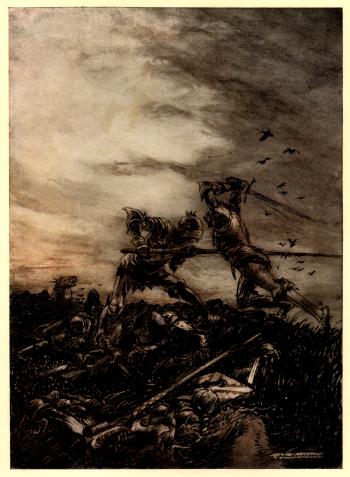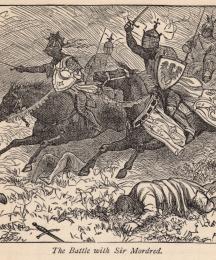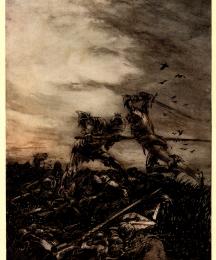
Camlan
Name Variants: Camlann
Camlan is often said to be the site of Arthur’s final battle. The battle of Camlan is first referred to in the Annales Cambriae (Welsh Annals), where, for the year 539 (given as 537 in most editions), it is described as a battle in which Arthur and Medraut (Mordred) fell; but there is no indication that they were fighting against each other or that they killed each other. The battle is alluded to in the Welsh tales Culhwch and Olwen and The Dream of Rhonabwy, in which Iddawg the Embroiler of Britain is said to have been sent by Arthur on a mission of peace to Medrawd; but by being deliberately provocative rather than conciliatory, he caused the battle instead of averting it. Triad 51 recounts Medrawd’s (Mordred’s) treachery (he is one of the three dishonored men of Britain and is said to be worse than Vortigern) and the battle at Camlan in which Medrawd and Arthur died. Triad 53 assigns the cause of the battle at Camlan to the blow with which Gwhenhwyfar was struck by Gwenhwyfach, said in Culhwch and Olwen to be her sister (an event also alluded to in Triad 84, where Camlan is called the most futile battle of the Island of Britain because it was instigated by such a barren cause as the quarrel between Gwenhwyfach and Gwhenhwyfar).
Geoffrey of Monmouth places Arthur’s final battle with Mordred at the River Camblan in 542. In the battle Mordred dies, and Arthur is carried off to the Isle of Avalon to have his wounds treated. Wace locates the battle by the River Camel near the entrance to Cornwall; and Layamon places it at Camelford on the River Tamar in Cornwall. Malory, following the Vulgate, locates the final battle on Salisbury Plain.
Geoffrey of Monmouth places Arthur’s final battle with Mordred at the River Camblan in 542. In the battle Mordred dies, and Arthur is carried off to the Isle of Avalon to have his wounds treated. Wace locates the battle by the River Camel near the entrance to Cornwall; and Layamon places it at Camelford on the River Tamar in Cornwall. Malory, following the Vulgate, locates the final battle on Salisbury Plain.
Bibliography
Breeze, Andrew. “The Battle of Camlan and Camelford, Cornwall.” Arthuriana 15.3 (Fall 2005): 75-90.
Brown, A. L. “Camlann and the Death of Arthur.” Folklore 72 (1961): 612-21
Nickel, Helmut. “Surviving Camlann.” Quondam et Futurus 3.1 (Spring 1993): 32-37.
Reno, Frank. “The Georgraphy of Camlann.” Chapter 6 in The Historic King Arthur: Authenticating the Celtic Hero of Post-Roman Britain. Jefferson, NC: McFarland, 1996. Pp. 179-201.
Buchanan, Robert (1785 - 1873)
Rhys, Ernest (1859 - 1946)
Dan Beard (1850 - 1941)
H. J. Ford (1860 - 1941)
F. A. Fraser (1846 - 1924)
Alfred Kappes (1850 - 1894)
Arthur Rackham (1867 - 1939)
Dan Beard (1850 - 1941)
H. J. Ford (1860 - 1941)

F. A. Fraser (1846 - 1924)

Alfred Kappes (1850 - 1894)

Arthur Rackham (1867 - 1939)








